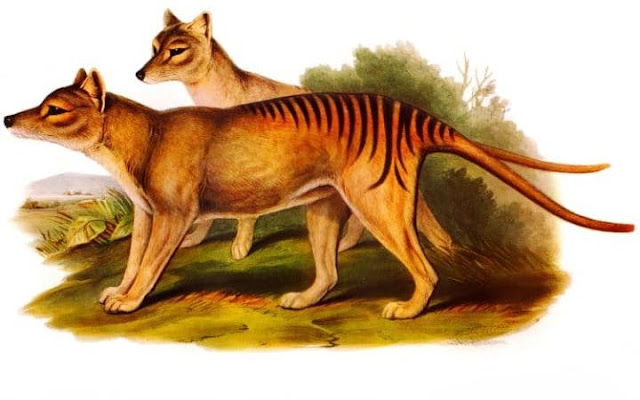 |
As part of a search due to begin next month, scientists plan to set up more than 50 camera traps to try to spot a so-called tiger, or thylacine, in Cape York, a peninsula in the country’s north-east corner.
 |
"These animals, I've never seen anything like them before in my life," he told ABC Radio.
"They were dog-shaped — I had a shepherd with me so I certainly know what dogs are about — and in the spotlight I could see they were tan in colour and they had stripes on their sides."
Patrick Shears, a former ranger who also claims to have seen a tiger, said local Aborigines reported regularly spotting the creature.
"They pretty well confirmed that they know about a dog-like creature — not a dingo [a native Australian dog] — that's often seen at night," he said.
"They call it the 'moonlight tiger'… They're curious. If you're not moving and not making a noise they'll come within a reasonable range and check you out then just trot off.”
"They were dog-shaped — I had a shepherd with me so I certainly know what dogs are about — and in the spotlight I could see they were tan in colour and they had stripes on their sides."
Patrick Shears, a former ranger who also claims to have seen a tiger, said local Aborigines reported regularly spotting the creature.
"They pretty well confirmed that they know about a dog-like creature — not a dingo [a native Australian dog] — that's often seen at night," he said.
"They call it the 'moonlight tiger'… They're curious. If you're not moving and not making a noise they'll come within a reasonable range and check you out then just trot off.”
Professor
Bill Laurance, one of two researchers from James Cook University
undertaking the search, said the sightings appeared to be credible but
admitted it seemed unlikely that the species would have survived in such
low numbers.
“All observations of putative thylacines to date have been
at night, and in one case four animals were observed at close range -
about 20 feet away - with a spotlight,” he said.
“We have cross-checked the descriptions we received of eye shine colour, body size and shape, animal behaviour, and other attributes, and these are inconsistent with known attributes of other large-bodied species in north Queensland such as dingoes, wild dogs or feral pigs.”
The Tasmanian tiger, a carnivorous marsupial which disappeared following the arrival of British settlers, has gained an almost mythical status in Australia.
The last known creature died on September 7, 1936 at a zoo in Hobart, the capital of the island state of Tasmania.
There have since been countless alleged sightings, but none
has ever been confirmed. Scientists in Australia have also been
attempting to clone it.
The creatures were believed to have once roamed the mainland but became extinct there – possibly after being preyed on by dingoes, Australian wild dogs – and were left only in Tasmania. They were then hunted and trapped by the colonialists, who believed the tiger was a threat to their sheep.
In recent years, several Australian animal and bird species thought to be extinct have reappeared.
But experts tend to treat sightings of the Tasmanian tiger with scepticism.
Most of the alleged sightings are believed to have been of feral cats or dogs, whose numbers are believed to be in the millions.
The recent sightings on Cape York in far north Queensland have occurred at two separate sites but the precise locations are being kept secret.
“We have cross-checked the descriptions we received of eye shine colour, body size and shape, animal behaviour, and other attributes, and these are inconsistent with known attributes of other large-bodied species in north Queensland such as dingoes, wild dogs or feral pigs.”
The Tasmanian tiger, a carnivorous marsupial which disappeared following the arrival of British settlers, has gained an almost mythical status in Australia.
The last known creature died on September 7, 1936 at a zoo in Hobart, the capital of the island state of Tasmania.
 |
The creatures were believed to have once roamed the mainland but became extinct there – possibly after being preyed on by dingoes, Australian wild dogs – and were left only in Tasmania. They were then hunted and trapped by the colonialists, who believed the tiger was a threat to their sheep.
In recent years, several Australian animal and bird species thought to be extinct have reappeared.
But experts tend to treat sightings of the Tasmanian tiger with scepticism.
Most of the alleged sightings are believed to have been of feral cats or dogs, whose numbers are believed to be in the millions.
The recent sightings on Cape York in far north Queensland have occurred at two separate sites but the precise locations are being kept secret.
“Everything is being handled with strict confidence, so we
won’t be able to say exactly where we are conducting the surveys aside
from it being on the Cape York Peninsula,” Professor Laurance said.
The search is due to start in late April after the local high river levels recede.
SOURCE : Telegraph.
The search is due to start in late April after the local high river levels recede.
SOURCE : Telegraph.